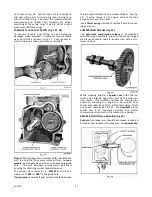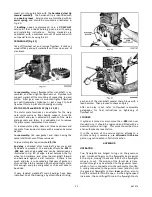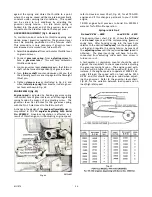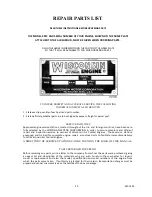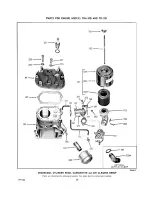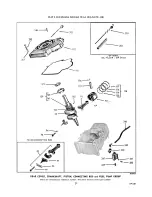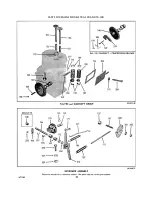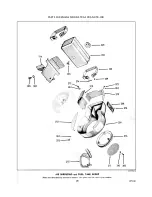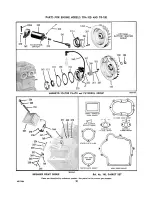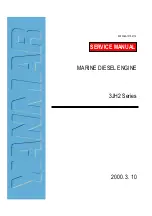
15 MI-1066
lated during the storage period.
Be sure to fill the crankcase with a good qual-
ity of crankcase oil to the high level mark before
starting the engine. Do not use any oil heavier
than S.A.E. No. 30.
It is also recommended to use a new spark plug at the
beginning of the next season, especially if the engine has
given considerable service.
Refuel engine and follow the starting instructions as
shown on the preceding pages of this manual.
It is highly recommended that machines be stor-
ed inside a building through the winter. If this
is not possible, the engine should be protected
from snow and ice by a proper covering.
TROUBLES
CAUSES AND REMEDIES
Three prime requisites are essential to starting and
maintaining satisfactory operation of gasoline en-
gines. They are:
1.
A proper fuel mixture
in the cylinder.
2.
Good compression
in the cylinder.
3.
Good spark, properly timed
, to ignite the mixture.
If all three of these conditions do not exist the en-
gine cannot be started. There are other factors which
will contribute to hard starting; such as, too heavy a
load for the engine to turn over at a low starting
speed, a long exhaust pipe with high back pressure,
etc. These conditions may affect the starting, but do
not necessarily mean that the engine is improperly
adjusted.
As a guide to locating any difficulties which might
arise the following causes are listed under the three
headings:
Fuel Mixture, Compression,
and
Ignition
.
In each case the causes of trouble are given in the
order in which they are most apt to occur. In many
cases the remedy is apparent, and no further remedies
are suggested.
STARTING DIFFICULTIES
FUEL MIXTURE
No fuel in tank or fuel shut-off valve closed.
Fuel pump diaphragm worn out, so pump does not
supply carburetor with fuel.
Carburetor not choked sufficiently, especially if en-
gine is cold.
See
‘Starting Procedure’, Page 8.
Water, dirt, or gum in gasoline interfering with free flow
of fuel to carburetor.
Poor grade or stale gasoline that will not vaporize
sufficiently to form the proper fuel mixture.
Carburetor flooded, caused by too much choking espe-
cially if engine is hot. See
‘Starting Procedure’,
Page 8.
Dirt or gum holding float needle valve in carburetor
open. This condition would be indicated if fuel con-
tinues to drip from carburetor with engine standing
idle. Often tapping the float chamber of the carbu-
retor very lightly with the handle of a screwdriver or
similar tool will remedy this trouble. Do not strike
carburetor with any metal tool.
If due to flooding, too much fuel should have entered
the cylinder in attempting to start the engine, the
mixture will most likely be too rich to burn. In that
case the spark plug should be removed, the engine
then turned over several times with the starting
sheave so the rich mixture will be blown out through
the spark plug hole. The choke on the carburetor
should of course be left open during this procedure.
The spark plug should be dried off, assembled, and
starting tried again.
COMPRESSION
The Model TRA-10D is furnished with an
automatic
compression release,
so that the normal method of
detecting faulty compression, by the resistance en-
countered when turning the engine over on the com-
pression stroke, no longer holds true.
Check the following for suspected lack of compression, if
the
fuel
and
ignition systems
are not the cause of
starting difficulties and loss of power.
Cylinder dry due to engine having been out of use
for some time.
See ‘Restoring Compression’, Page
14.
Loose or broken spark plug. In this case a hissing
noise will be heard in cranking engine due to es-
caping gas mixture on compression stroke.
Damaged cylinder head gasket or loose cylinder
head. This will likewise cause a hissing noise on
compression stroke.
Valve tappets with insufficient clearance under
valve stems.
See ‘Tappet Adjustment’, Page 19.
If correcting the above conditions does not remedy
the situation, it will be necessary to partially dis-
mantle the engine and check for:
Valve stuck open due to carbon or gum on valve
stem. To clean valve stems
, see ‘Valves and Seat
Insert’, Page 18.
Piston rings stuck in piston due to carbon accumu-
lation. This will require removing the piston and con-
necting rod assembly, and cleaning parts.
See ‘Con-
necting Rod and Piston’, Page 20.
IGNITION
See ‘Ignition Spark’, Page 10.
No spark may also be
attributed to the following:
Ignition wires disconnected from magneto, coil, spark
plug or breaker box.
Broken ignition wires causing short circuits.
Spark plug cable wet or oil soaked.
Spark plug insulator broken.
Содержание Air Cooled TR-10D
Страница 6: ...MI 937 2 4 Fig 1 289860C TAKE OFF rear and LEFT HAND SIDE VIEW of ENGINE...
Страница 7: ...5 MI 938 2 FAN END front and RIGHT HAND SIDE VIEW of ENGINE...
Страница 8: ...MI 939 2 6 SECTIONAL VIEWS OF ENGINE...
Страница 28: ......
Страница 29: ...PARTS FOR ENGINE MODELS TRA 10D AND TR 10D...
Страница 30: ...PARTS FOR ENGINE MODELS TRA 10D AND TR 10D...
Страница 31: ...PARTS FOR ENGINE MODELS TRA 10D AND TR 10D...
Страница 32: ......
Страница 33: ......
Страница 34: ......
Страница 35: ......
Страница 36: ......
Страница 37: ......
Страница 38: ......
Страница 39: ......
Страница 40: ......
Страница 44: ......
Страница 46: ...WISCONSIN MOTOR CORPORATION MILWAUKEE WISCONSIN 532466 PRINTED IN U S A...






















